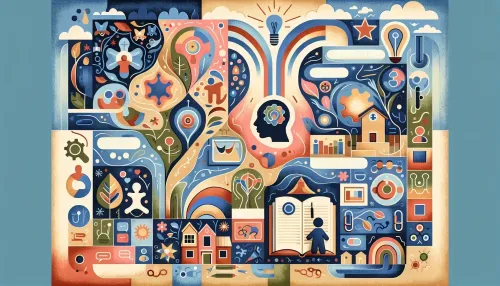Deciphering Autism Spectrum Disorder: A Gateway Guide for Parents and Educators

Autism Spectrum Disorder (ASD) presents a complex landscape for parents and educators alike. Understanding the nuances of this developmental condition is crucial in providing effective support and guidance for children on the spectrum. From recognizing early signs to implementing tailored intervention strategies, navigating the world of autism requires knowledge, empathy, and an unwavering dedication to empowering autistic individuals. This comprehensive guide aims to shed light on the multifaceted dimensions of ASD, equip you with essential tools for effective intervention, and debunk prevalent myths that often cloud our understanding of autism.
Understanding Autism Spectrum Disorder (ASD)
At the heart of comprehending ASD lies an exploration of its diverse spectrum. ASD encapsulates a wide range of conditions characterized by challenges in social skills, repetitive behaviors, speech and nonverbal communication. From the more severely impaired individuals requiring significant support to high-functioning individuals with milder symptoms, the spectrum encompasses a broad array of strengths and needs. This understanding underscores the need for individualized approaches tailored to the unique profile of each child on the spectrum.
What is Autism Spectrum Disorder?
Recognizing the early signs of autism is pivotal in facilitating timely intervention. While developmental milestones vary among children, certain red flags warrant attention. Delays in babbling, gestures, or spoken language; aversion to eye contact; fixation on specific objects; and atypical responses to sensory stimuli are among the key indicators that necessitate further evaluation.
Recognizing Early Signs of Autism
Obtaining a formal autism diagnosis involves a collaborative effort between healthcare professionals, educators, and families. The process typically entails comprehensive assessments encompassing developmental history, behavioral observations, and standardized evaluations. Following diagnosis, partnering with specialists can aid in designing targeted interventions aligned with your child's specific needs.
The etiology of autism remains a subject of rigorous research and discourse. While genetic predispositions are implicated in ASD, environmental factors and neurological atypicalities also contribute to its manifestation. Understanding these multifaceted influences is pivotal in shaping our approach to support and intervention.
Navigating the Autism Diagnosis Process
Navigating the myriad intervention strategies available can be overwhelming. From applied behavior analysis (ABA) to speech therapy and occupational therapy, identifying the most suitable approach hinges on recognizing your child's strengths and areas for growth. Collaborating with a multidisciplinary team can help tailor interventions that optimize your child's developmental trajectory.
Theories Behind Autism: Genetics and Environment
Effective communication lies at the core of fostering meaningful connections with autistic children. Augmentative and alternative communication (AAC) systems, visual supports, and social stories are invaluable tools that enhance comprehension and expression among individuals with ASD.
Effective Intervention Strategies for ASD
Inclusive educational settings form the bedrock for nurturing the potential of autistic learners. Adapting teaching methodologies, offering sensory accommodations, and promoting peer understanding can foster an environment where all students thrive.
Empowerment encompasses nurturing self-advocacy skills and fostering independence within autistic children. Encouraging self-regulation, promoting autonomy in daily tasks, and cultivating self-awareness nurtures a sense of agency crucial for their holistic development.
Communicative Approaches to Enhance Understanding
Embracing the journey with ASD necessitates a robust support system for families. Establishing connections with other parents facing similar challenges can provide emotional sustenance while also fostering an exchange of valuable insights. Implementing self-care practices and seeking respite when needed is instrumental in fortifying parental well-being amidst the demands of caring for an autistic child.
Creating Inclusive Classrooms for Autistic Learners
Dispelling prevalent misconceptions surrounding autism is pivotal in fostering an informed discourse. Dismantling myths related to vaccines, parenting practices, and autistic individuals' capabilities promotes a climate of understanding rooted in evidence-based knowledge.
Through concerted efforts rooted in empathy, understanding, and evidence-based practices, we endeavor to create a landscape where autistic children flourish within supportive communities grounded in respect and inclusion.
Frequently Asked Questions
Early signs of autism can include delays in babbling or gestures, aversion to eye contact, fixation on specific objects, and unusual responses to sensory stimuli. Recognizing these red flags is crucial for timely intervention, as each child's developmental milestones may vary significantly.
The autism diagnosis process involves collaboration among healthcare professionals, educators, and families. It typically includes comprehensive assessments that evaluate developmental history, behavioral observations, and standardized tests. Following diagnosis, specialists can help design targeted interventions tailored to the child's unique needs.
Intervention strategies for autistic children vary widely and may include applied behavior analysis (ABA), speech therapy, and occupational therapy. Identifying the most effective approach depends on understanding each child's strengths and challenges, often requiring collaboration with a multidisciplinary team for optimal support.
Check Out These Related Articles

Breaking Down Barriers: Redefining Physical Education for Autistic Children's Holistic Development

Fostering Entrepreneurial Skills in Autistic Adolescents: Nurturing Business Acumen and Innovation

School Days Simplified: Tailoring Education Plans for Autistic Students
